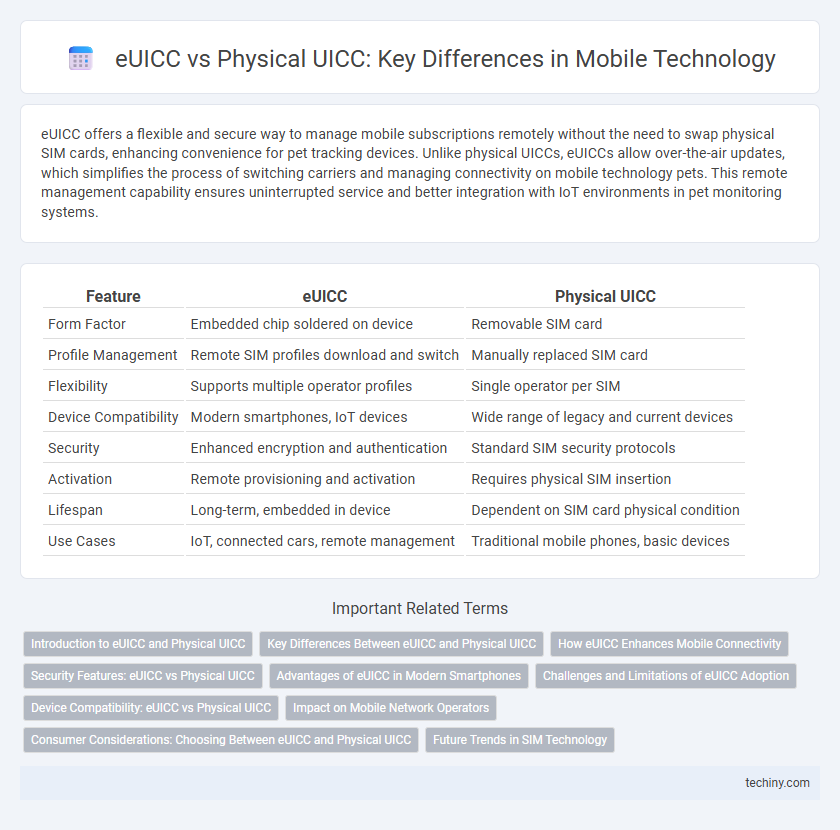eUICC offers a flexible and secure way to manage mobile subscriptions remotely without the need to swap physical SIM cards, enhancing convenience for pet tracking devices. Unlike physical UICCs, eUICCs allow over-the-air updates, which simplifies the process of switching carriers and managing connectivity on mobile technology pets. This remote management capability ensures uninterrupted service and better integration with IoT environments in pet monitoring systems.
Table of Comparison
| Feature | eUICC | Physical UICC |
|---|---|---|
| Form Factor | Embedded chip soldered on device | Removable SIM card |
| Profile Management | Remote SIM profiles download and switch | Manually replaced SIM card |
| Flexibility | Supports multiple operator profiles | Single operator per SIM |
| Device Compatibility | Modern smartphones, IoT devices | Wide range of legacy and current devices |
| Security | Enhanced encryption and authentication | Standard SIM security protocols |
| Activation | Remote provisioning and activation | Requires physical SIM insertion |
| Lifespan | Long-term, embedded in device | Dependent on SIM card physical condition |
| Use Cases | IoT, connected cars, remote management | Traditional mobile phones, basic devices |
Introduction to eUICC and Physical UICC
eUICC (embedded Universal Integrated Circuit Card) is a programmable SIM embedded directly into devices, enabling remote profile management and greater flexibility compared to traditional physical UICCs. Physical UICCs are removable SIM cards that store subscriber identity and network credentials, requiring manual swapping to change operators or profiles. eUICC technology streamlines connectivity for IoT devices and mobile users by supporting multiple profiles without physical card replacement.
Key Differences Between eUICC and Physical UICC
eUICC offers remote SIM provisioning, enabling users to switch carriers without physically replacing the card, unlike the traditional Physical UICC that requires manual card swaps. The embedded design of eUICC enhances device durability and supports multiple profiles, while Physical UICC chips are limited to a single carrier profile at a time. Security features in eUICC include OTA updates and dynamic credential management, contrasting with the static nature of Physical UICC security configurations.
How eUICC Enhances Mobile Connectivity
eUICC enhances mobile connectivity by enabling remote provisioning and management of multiple mobile network operator profiles on a single embedded SIM, eliminating the need to physically change SIM cards. This technology supports seamless switching between carriers, improving global roaming capabilities and reducing downtime. Its security features and flexibility also facilitate IoT device integration and scalable mobile network deployments.
Security Features: eUICC vs Physical UICC
eUICC offers enhanced security features by enabling remote SIM provisioning and dynamic profile management, reducing risks of physical theft and cloning that are common with Physical UICC cards. eUICC supports secure authentication protocols such as mutual authentication and encrypted key exchange, which improve protection against unauthorized access. Physical UICC, while robust in hardware security, lacks the flexibility and advanced remote management capabilities that make eUICC superior in mitigating modern mobile security threats.
Advantages of eUICC in Modern Smartphones
eUICC technology offers unprecedented flexibility in modern smartphones by enabling remote SIM provisioning and multiple carrier profiles without the need for physical SIM swaps. This reduces device downtime, enhances security through over-the-air updates, and supports seamless global connectivity for users traveling internationally. The compact form factor of eUICC also frees up valuable internal space within smartphones, allowing for sleeker designs and additional hardware innovations.
Challenges and Limitations of eUICC Adoption
eUICC adoption faces challenges including limited device compatibility and complex carrier interoperability, which hinder seamless integration across networks. Security concerns surrounding remote profile management and potential vulnerabilities in eUICC provisioning slow regulatory acceptance. High implementation costs combined with lack of standardized global frameworks further restrict widespread deployment in mobile ecosystems.
Device Compatibility: eUICC vs Physical UICC
eUICC technology enhances device compatibility by enabling remote SIM provisioning, allowing multiple carrier profiles to be activated without swapping physical cards, which is especially beneficial for IoT devices and dual-SIM smartphones. Physical UICC cards require manual replacement for changing carriers, limiting flexibility and increasing downtime. The eUICC's embedded design supports seamless transitions across networks globally, optimizing connectivity for modern mobile devices.
Impact on Mobile Network Operators
eUICC technology enables Mobile Network Operators (MNOs) to remotely provision and manage multiple carrier profiles on a single embedded SIM, reducing logistical costs and enhancing customer flexibility. Physical UICCs require significant inventory management and manual SIM swaps, increasing operational expenses and limiting rapid service activation. The shift to eUICC supports MNOs in accelerating device onboarding, optimizing network resource allocation, and improving global roaming capabilities.
Consumer Considerations: Choosing Between eUICC and Physical UICC
Consumers choosing between eUICC and physical UICC should consider the convenience of remote SIM provisioning offered by eUICC, which allows seamless switching between carriers without needing a new SIM card. Physical UICC requires manual swapping and may be preferred by users who prioritize control over their SIM card or in regions with limited eUICC support. Battery life impact, device compatibility, and security features also play crucial roles in determining the best choice for individual mobile technology needs.
Future Trends in SIM Technology
eUICC technology is revolutionizing mobile connectivity by enabling remote SIM provisioning and management, eliminating the need for physical SIM cards and enhancing device flexibility. Future trends in SIM technology emphasize broader adoption of embedded SIMs (eUICC) across IoT devices and smartphones, supporting seamless network switching and improved security protocols. The shift from physical UICCs to eUICCs is driven by increasing demand for scalable, cost-efficient, and user-friendly mobile network solutions globally.
eUICC vs Physical UICC Infographic

 techiny.com
techiny.com